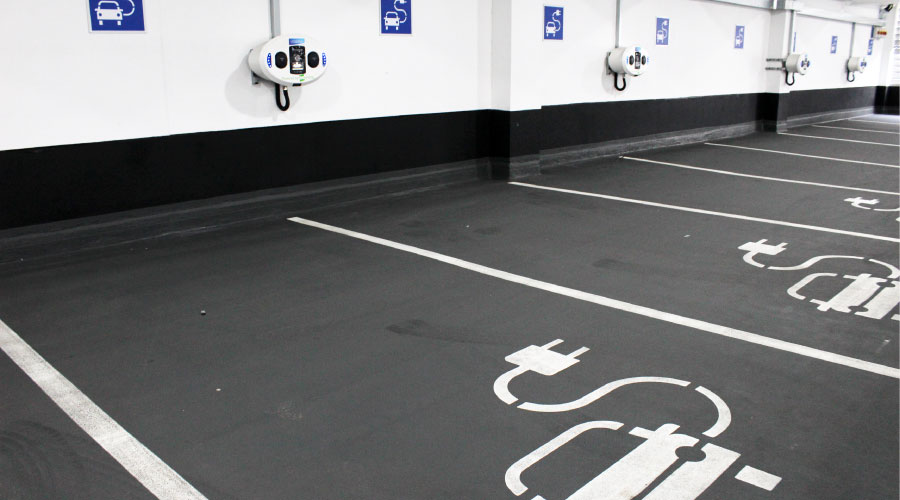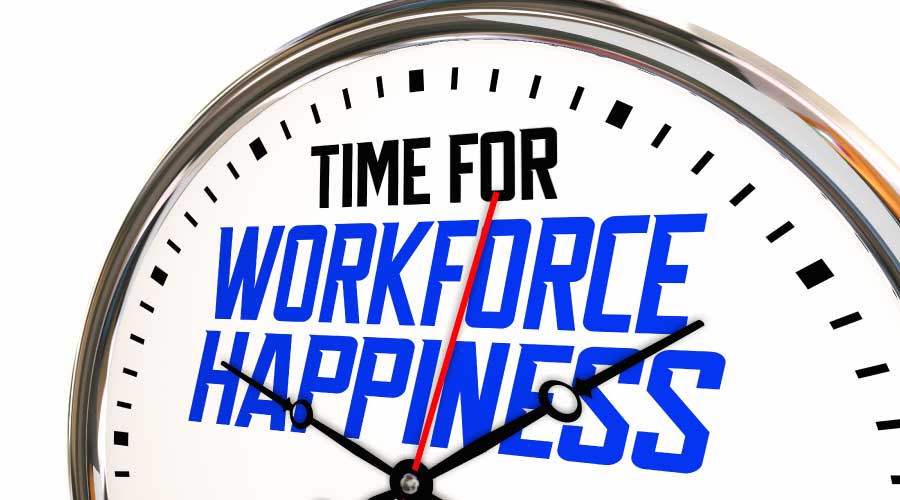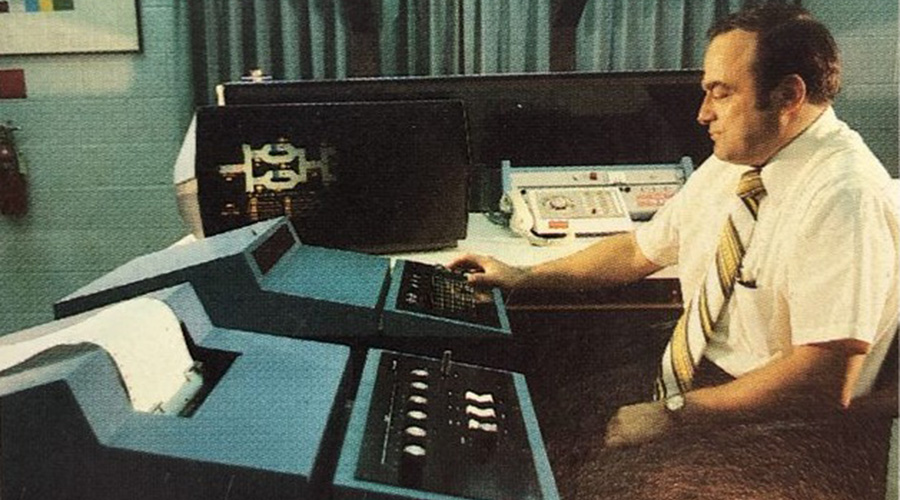Tailor Made
Work spaces that are custom-designed for collaboration are helping corporations change their cultures
Today’s companies know that corporate culture can mean the difference between success and failure. Many are using the design of their offices to support or even drive cultural change.
If you were to walk into a building lobby and find yourself standing on a marble floor, surrounded by traditional, upright furniture and dark paneling, you wouldn’t be surprised to learn you were inside a bank’s headquarters. And it’s a good bet that the finishes would become higher-end and private offices grow larger as you neared the C-suite.
Those visual clues communicate a formal, hierarchical culture. Banking companies typically want to send a clear message to clients and employees that they are serious about financial responsibilities.
Now picture a loft space with a polished concrete floor, exposed ceilings, open work spaces, and large, overstuffed furniture in casual meeting areas. Those elements suggest a firm engaged in some type of creative services. That environment hints at a flat organization with an informal culture emphasizing teamwork and an open exchange of ideas.
The characteristics of a workplace — particularly in the public, meeting and food service areas — offer many clues about what type of company resides there. But what’s most important is that, in reflecting a company’s mission or beliefs, the space should contribute to creating a culture that enables an organization to maximize its potential.
Many businesses, from buttoned-down banks to more freewheeling ad agencies, are realizing how critical it is to establish a culture that encourages collaboration. The goal is to institutionalize creativity and innovation.
This push toward creative thinking is requiring people to work more as teams. Organizations want space that enables true knowledge-sharing. Often this means reducing the size of individual workspaces to free up more room for community areas, meeting spaces, cafeterias and other amenities that support a collaborative, learning-based culture.
Here are some recent examples of companies that have used design to support or change their cultures:
At the Motorola headquarters in Schaumburg, Ill., the company completely renovated its 18,000-square-foot executive floor offices on the 12th floor of a 1970s office building. Once upon a time, the office had an old school, “fortress” feel to it. Heavy wood paneling, staid beige carpeting and antiques suggested that this was a place where serious business was being conducted behind closed doors. The “ivory tower” feel of the Motorola executive suite was inescapable.
Fast-forward 25 years and the executive floor is virtually unrecognizable, a direct reflection of CEO Ed Zander’s approach to running the company. He is a strong believer in open work environments that encourage creative collaboration. As a result, the paneling and spacious corner offices were replaced with new workspace standards, plentiful natural light and an emphasis on design that says high-tech and high-energy. Today, Zander himself works in a 15-by-15-foot interior office with a glass front.
IndyMac Bank’s new space on the top two floors of a new Pasadena, Calif., high-rise helped establish a traditional identity for the bank’s headquarters. To support senior management’s desire to express the company’s image as a well-established bank that takes its work seriously, the space has many private offices, wood paneling and high-end finishes.
Yet IndyMac’s leaders also wanted the space to support a culture that encourages communication. The solution was to create a circular staircase connecting the two floors as a place where people can encounter coworkers and have casual interactions. Placing private offices on the interior of the space rather than around the perimeter allows natural light to reach the workstations. Using glass on the front walls of private offices portrays a transparent management culture and a genuine open-door policy.
One goal for the design of Ascent Media’s 100,000-square-foot Digital Media Distribution Center in Burbank, Calif., was to use the workplace to blend the cultures of two different media groups that had merged under the Ascent Media name into a single culture that emphasized communication and collaboration. At the employee entrance, the design provided a community space with a cappuccino bar, e-mail pickup areas, soft seating and lockers. Near the client entrance, casual breakout booths allow employees and clients to meet in comfort without feeling like they’re in a formal conference room.
The Workplace Resources team at Cisco Systems used its workplace to drive cultural change in the redesign of its 14,000-square-foot Building 14 offices at the company’s San Jose headquarters campus.
One specific challenge was to “think out of the cube” and help create a corporate culture that would drive competitive advantage. Rather than providing dedicated spaces for individuals, the new office layout is planned so that space is used for the specific activity being performed in each location. The new space enables all employees to be mobile within the office. There are few assigned offices or cubes, though employees have access to private or reserved space when they need to do heads-down work.
The design created an office environment that’s smaller and more cost effective, yet much better tailored to the needs of Cisco’s workforce. It drives Cisco’s corporate culture toward one of teaming and interaction.
The project is a prototype for future Cisco offices across the country. A post-occupancy survey showed that the redesign doubled Cisco’s space utilization, cut furniture and cabling costs in half, and greatly increased employee satisfaction. The percentage of employees who were “extremely satisfied” with the space jumped from 18 percent to 35 percent.
Manage the Change
No matter how well-planned and positive the changes are, companies making significant modifications to the workplace will encounter resistance from employees. Organizations should never attempt to make major changes to office space without a thoughtful, focused change management plan. The challenge is to quell employee fears about losing status and to assure them that the new plan will accommodate their requirements for heads-down concentration.
The most successful projects incorporate a change management plan that makes employees active participants in the process and builds consensus along the way. Organizations should ensure that everyone understands exactly what is happening and why it’s important to both the company and the staff.
The Move to Open Offices
Moving from mostly private to open offices, for example, can be traumatic for people. An interactive change management plan helps employees accept this change when they realize that in exchange for losing perceived “status,” they’re gaining features like better acoustics, quality lighting and amenities such as a cafeteria, fitness center, outdoor meeting spaces, or a daycare center. And the company will still accommodate their needs for quiet areas. Employees tend to be happier if they understand the company is trying to make their lives easier.
For Symantec’s move to 100 open offices, two test spaces were designed. These test sites helped Symantec understand what did and didn’t work in the new environment. In that case, a post-occupancy survey showed that people didn’t like meeting in the informal team areas that were placed along open circulation corridors because there was too much activity around them. The survey also revealed that the project with a built-in change management process received a 30 percent higher satisfaction rating from employees.
For Aera Energy’s move to 100 percent open offices in its Bakersfield, Calif., headquarters, a planning process that included seeking the buy-in of several key stakeholders took a full year. The construction of the office space only took nine months, but this was the right balance for Aera Energy. With very concentrated efforts, other change management programs have been completed in less than 60 days.
Sidestepping the Pitfalls
The road to using office design to support a new corporate culture is scattered with potential roadblocks. Experience shows ways to avoid problems:
Don’t get too comfortable. One big challenge in creating more egalitarian environments is to keep the space just hierarchical enough that people maintain a sense of individual responsibility. Though employees should be comfortable in their work environments, the workplace shouldn’t feel like a playground. So instead of the beanbags that came with the dot-com era, for example, companies are putting in sofas and comfortable chairs. The space needs to be comfortable yet formal enough to remind employees that they have a job to do.
Keep up with change. Companies are changing rapidly. Facility executives should make work environments as flexible as possible to accommodate the shifting space and technological needs that come with cultural changes.
Teaming areas should not be afterthoughts. Money should not be spent on expensive, attractive furniture that will never be used. The problem is that designers tend to place informal meeting spaces in locations that are convenient for the space plan, such as around main aisles or in locations where workstations don’t fit. But people don’t necessarily like to team in these locations. The goal is to identify where people need to work as teams. It’s distracting if they’re sitting directly in the traffic path, for example. Teams often thrive in nooks and corners with access to daylight and attractive views to the outside.
Accommodate a mix of personalities. While all employees should have opportunities to talk and share ideas, workplace planners have to remember that introverts actually lose energy when they’re around too many people. Their energy will dissipate if they don’t have protected environments where they have the opportunity to recharge.
At Aera Energy, the team recognized that the company’s engineers were predominantly introverted. The plan placed their workstations in protected enclaves in isolated areas of the space. Yet even these modules are arranged around flexible teaming areas equipped with collaborative tools like moveable tables and mobile display boards.
Recognize the need for personal space. As mammals, people are instinctively territorial and like to have some personal space to call their own. Providing employees with their own space gives them a sense of worth and builds loyalty. The challenge for facility executives is to balance how much space an employee can personalize with the amount of open space provided for use by groups of employees.
Watch out for culture clashes. A clash of cultures can occur when two very different companies merge into one work environment. Take, for example, a company that was thriving with an extremely entrepreneurial approach and loose organization. When that company merged with a very buttoned-down, hierarchical company, there was mass confusion among management. An entrepreneur might have a buttoned-down manager reporting to him or her, and that person would be supervising another entrepreneur.
The solution was to help bridge the communication gaps as much as possible. Asking the entrepreneurial group how to help them dot their i’s and cross their t’s was essential to keeping the project moving. Alternately, reassuring the buttoned-down executive that the entrepreneur in the office next door was a smart leader with a track record of success was also important.
Work from the top down. It requires leadership and commitment to carry out a facility plan that transforms office culture. On one project involving a move to open offices, the CEO told the company’s employees himself why the change was so important. On a subsequent open-office project for that same company, a facilities person relayed the message for the CEO. That second project was not nearly as well-received by employees. The change needs to be clearly introduced and strongly reinforced by senior management.
For Aera Energy’s headquarters, the design team planned a workplace that integrated the merged business units of Shell and Mobil into a 100 percent open office environment. Moving into an open plan with universal workstation sizes and standard furniture represented a huge cultural change for executives accustomed to their private offices. But one reason this project succeeded is that Aera’s CEO never wavered in his desire to move to all open offices in order to foster collaboration and create an office environment where people made a connection between the space and their purpose, vision and values. He explained to employees that they were being asked to give up their private offices for the good of the company. Today, employees love the space and have said they would never go back to closed offices because closed offices are too confining and isolating.
BRIDGING THE GAP
Sparking Biogen Idec’s New Culture of Collaboration
A recent project in Southern California for one of the world’s largest biotechnology companies shows how a work environment can catalyze a completely new culture that drives business success.
Biogen Idec wanted to use its new San Diego Research and Corporate Campus to spark creativity and trigger a new culture of collaboration among its scientists and their administrative colleagues. Researchers tend to be as introverted as their sales and marketing co-workers are extroverted. It’s not uncommon in research organizations for talented scientists working side-by-side each day not to share information with one another — let alone with their sales and marketing teams.
The challenge of encouraging these introverted, highly knowledgeable individuals to interact throughout the organization was complicated by the fact that the new laboratory building and the administrative buildings are on opposite sides of a man-made stream and natural arroyo that bisects the campus. While the special HVAC and safety needs of the lab building made it cost effective to keep that structure separate, it also made it harder to encourage employees to mix.
The first solution was to create community areas in the lab buildings where researchers could meet during breaks. Outdoor balconies and quiet enclaves sprinkled throughout the building encourage informal interaction. Even introverted people will mix when they have good coffee, food and sunlight waiting for them outside their labs. And they can become more extroverted in these relaxed settings than when they are doing solitary lab work.
To entice the researchers and administrative people from opposite sides of the arroyo to move back and forth and mingle, the plan places conference rooms and a café in the administrative building. On the other side of the ravine are a full-service cafeteria and a fitness center in the commons building next to the lab building.
The buildings are linked by a wide, glass-enclosed bridge. This bridge, with its panoramic campus views and comfortable seating areas, has become a busy pathway and popular area of interaction for employees of all levels at Biogen Idec.
“There is a much stronger spirit of camaraderie and community,” says Connie Matsui, Biogen Idec’s executive vice president, corporate strategy and communications. “This space has spawned more ‘connecting on the fly’ than was possible in our old, fragmented bunch of buildings.”
As an executive, Matsui enjoys running into employees at all levels of the company in these interactive areas — and vice versa. “The executive team is not perceived as strangers or elitists, but rather as regular employees regardless of hierarchy,” she says. “Based on the ease and eagerness with which people greet each other, the connections are clearly social as well as professional.”
Matsui believes the sense of well-being among employees transfers to anyone who comes to the campus, including Biogen Idec’s external partners and collaborators. “Throughout the site there is a feeling of understated elegance and human interest that generates appreciation and respect for all that the company has contributed and accomplished,” she says. “Our visitors are therefore much more likely to be happy and cooperative.”
— Pamela Light
|
FIVE KEYS
WHAT MAKES A COLLABORATIVE ENVIRONMENT?
Five functional elements help unlock creativity and collaboration in office environments. These keys to a company’s culture:
- A flexible, sophisticated IT infrastructure. Wireless workplaces, for example
- Space that is comfortable in terms of features like acoustics, ergonomics, lighting and temperature control
- Healthy environments with fresh air and plenty of natural light
- A wide variety of meeting environments including meeting tables, sofas, chairs and stand-up café areas
- New collaborative work tools like interactive white boards, plasma screens, collaborative software, IP phones and videoconferencing equipment
— Pamela Light
|
Pamela Light is senior vice president and principal in the Los Angeles office of HOK, a global architectural design and services firm. She currently serves as president of the International Interior Design Association (IIDA). Her project work includes the entertainment, corporate, technology, biotechnology, hospitality and government sectors.
Related Topics:











